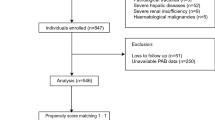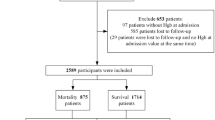Abstract
Summary
Malnutrition is associated with complications and mortality in patients of hip fracture. Prealbumin may be more suitable than albumin to accurately predict the prognosis of hip fracture in elderly patients. We found that prealbumin concentration was nonlinearly associated with mortality in elderly patients with hip fracture, and an inflection point effect was observed.
Objective
To evaluate the association between prealbumin concentration at admission and mortality in elderly patients with hip fractures.
Methods
Elderly patients with hip fractures were screened between Jan 2015 and Sep 2019. Demographic and clinical characteristics of the patients were collected. Linear and nonlinear multivariate Cox regression models were used to identify the association between prealbumin concentration at admission and mortality. All analyses were performed using EmpowerStats and the R software.
Results
This cohort study included 2387 patients who met the study criteria. The mean follow-up was 37.64 months. The prealbumin concentration was 162.67 ± 43.2 mg/L. Multivariate Cox regression showed that prealbumin concentration was associated with mortality in geriatric patients with hip fracture (hazard ratio [HR] = 0.95, 95% confidence intervals [CI]: 0.93–0.97, P < 0.0001). In addition, an inflection point effect was observed in the nonlinear association. The inflection point was 162.2 mg/L. If it is less than this inflection point, then every 10 mg/L increase in prealbumin was associated with a 7% reduction in the risk of death (HR = 0.93, 95%CI: 0.90–0.96, P < 0.0001). When greater than the inflection point, there was no difference in the risk of death (HR = 0.99, 95%CI: 0.95–1.03, P = 0.5127).
Conclusion
The prealbumin concentrations at admission were nonlinearly associated with long-term mortality in geriatric hip fractures, and 162.2 mg/L could be considered a prognostic factor of mortality risk.




Similar content being viewed by others
Data availability
The data was implemented by Xi’an Honghui Hospital. According to relevant regulations, the data could not be shared, but could be requested from correspondence author.
References
Cooper C, Campion G, Melton LJ 3rd (1992) Hip fractures in the elderly: a world-wide projection. Osteoporos Int 2:285–289
Lauritzen JB, Schwarz P, Lund B, McNair P, Transbøl I (1993) Changing incidence and residual lifetime risk of common osteoporosis-related fractures. Osteoporos Int 3:127–132
Roche JJ, Wenn RT, Sahota O, Moran CG (2005) Effect of comorbidities and postoperative complications on mortality after hip fracture in elderly people: prospective observational cohort study. BMJ 331:1374
Katsanos S, Sioutis S, Reppas L, Mitsiokapa E, Tsatsaragkou A, Mastrokalos D, Koulalis D, Mavrogenis AF (2023) What do hip fracture patients die from? Eur J Orthop Surg Traumatol 33:751–757
Lim SL, Ong KC, Chan YH, Loke WC, Ferguson M, Daniels L (2012) Malnutrition and its impact on cost of hospitalization, length of stay, readmission and 3-year mortality. Clin Nutr 31:345–350
Beck FK, Rosenthal TC (2002) Prealbumin: a marker for nutritional evaluation. Am Fam Physician 65:1575–1578
Li JD, Diao YK, Li J et al (2021) Association between preoperative prealbumin level and postoperative mortality and morbidity after hepatic resection for hepatocellular carcinoma: a multicenter study from a HBV-endemic area. Am J Surg 221:1024–1032
Thomas L, Robert D (1979) Nutritional status and body composition in critically ill patients. Relationship between results and mortality. Am J Clin Nutr 32:510–511
Perez Valdivieso JR, Bes-Rastrollo M, Monedero P, de Irala J, Lavilla FJ (2008) Impact of prealbumin levels on mortality in patients with acute kidney injury: an observational cohort study. J Ren Nutr 18:262–268
Terrier N, Jaussent I, Dupuy AM, Morena M, Delcourt C, Chalabi L, Rouanet C, Canaud B, Cristol JP (2008) Creatinine index and transthyretin as additive predictors of mortality in haemodialysis patients. Nephrol Dial Transplant 23:345–353
Gao C, Zhang B, Zhang W, Pu S, Yin J, Gao Q (2011) Serum prealbumin (transthyretin) predict good outcome in young patients with cerebral infarction. Clin Exp Med 11:49–54
Gao C, Dan Zeng CD, Tong YX, Zhu L, Zhang S (2022) Preoperative low prealbumin is associated with recurrence in patients with stage II/III gastric cancer after laparoscopic D2 gastrectomy. Front Surg 9:819514
Maruyama S, Okamura A, Kanie Y, Sakamoto K, Fujiwara D, Kanamori J, Imamura Y, Kumagai K, Watanabe M (2022) C-reactive protein to prealbumin ratio: a useful inflammatory and nutritional index for predicting prognosis after curative resection in esophageal squamous cell carcinoma patients. Langenbecks Arch Surg 407:1901–1909
Rasheed S, Woods RT (2014) An investigation into the association between nutritional status and quality of life in older people admitted to hospital. J Hum Nutr Diet 27:142–151
Liu M, Ji S, Yang C, Zhang T, Han N, Pan Y, Xu X, Lin J, Sun G (2022) Prealbumin as a nutrition status indicator may be associated with outcomes of geriatric hip fractures: a propensity score matching and 1-year follow-up study. Aging Clin Exp Res 34:3005–3015
Zhou GX, Xie QM, Zhang CJ, Yang N, Chen JP, Qin CT (2021) Correlation analysis of one-year postoperative mortality, preoperative serum indexes and postoperative nutrition guidance in elderly hip fracture patients. Zhongguo Gu Shang 34:605–611
Stone AV, Jinnah A, Wells BJ, Atkinson H, Miller AN, Futrell WM, Lenoir K, Emory CL (2018) Nutritional markers may identify patients with greater risk of re-admission after geriatric hip fractures. Int Orthop 42:231–238
Sun LN, Mu ZJ, Zhao L, Han Q, Jia KB, Xiu SL (2022) Related factors analysis of falls in old people with type 2 diabetes. China Diseases 23:99–102
Bretscher C, Buergin M, Gurzeler G et al (2023) Association between prealbumin, all-cause mortality, and response to nutrition treatment in patients at nutrition risk: secondary analysis of a randomized controlled trial. JPEN J Parenter Enteral Nutr 47:408–419
Ranasinghe RN, Biswas M, Vincent RP (2022) Prealbumin: the clinical utility and analytical methodologies. Ann Clin Biochem 59:7–14
Ueda M, Obayashi K, Ikeda K, Ando Y (2014) Nutrition support as team medical care. Rinsho Byori 62:1137–1142
Dennis RA, Johnson LE, Roberson PK, Heif M, Bopp MM, Cook J, Sullivan DH (2008) Changes in prealbumin, nutrient intake, and systemic inflammation in elderly recuperative care patients. J Am Geriatr Soc 56:1270–1275
Hoekstra JC, Goosen JH, de Wolf GS, Verheyen CC (2011) Effectiveness of multidisciplinary nutritional care on nutritional intake, nutritional status and quality of life in patients with hip fractures: a controlled prospective cohort study. Clin Nutr 30:455–461
Duncan DG, Beck SJ, Hood K, Johansen A (2006) Using dietetic assistants to improve the outcome of hip fracture: a randomised controlled trial of nutritional support in an acute trauma ward. Age Ageing 35:148–153
Devoto G, Gallo F, Marchello C, Racchi O, Garbarini R, Bonassi S, Albalustri G, Haupt E (2006) Prealbumin serum concentrations as a useful tool in the assessment of malnutrition in hospitalized patients. Clin Chem 52:2281–2285
Schürch MA, Rizzoli R, Slosman D, Vadas L, Vergnaud P, Bonjour JP (1998) Protein supplements increase serum insulin-like growth factor-I levels and attenuate proximal femur bone loss in patients with recent hip fracture. A randomized, double-blind, placebo-controlled trial. Ann Intern Med 128:801–809
Botella-Carretero JI, Iglesias B, Balsa JA, Arrieta F, Zamarrón I, Vázquez C (2010) Perioperative oral nutritional supplements in normally or mildly undernourished geriatric patients submitted to surgery for hip fracture: a randomized clinical trial. Clin Nutr 29:574–579
Berggren M, Stenvall M, Englund U, Olofsson B, Gustafson Y (2016) Co-morbidities, complications and causes of death among people with femoral neck fracture - a three-year follow-up study. BMC Geriatr 16:120
Parker MJ, Chatterjee R, Onsa M, Cawley S, Gurusamy K (2023) Cemented versus uncemented hemiarthroplasty for displaced intracapsular fractures of the hip. Bone Joint J 105-b:1196–1200
Brossa Torruella A, Tobias Ferrer J, Zorrilla Ribeiro J, López Borras E, Alabart Teixidó A, Belmonte Garridof M (2005) Mortality after hip fracture: a three year follow-up study. Med Clin (Barc) 124:53–54
Takagi K, Matsugaki R, Fujimoto K, Mine Y, Muramatsu K, Fujino Y, Matsuda S (2023) Analysis of the risk factors of mortality in elderly patients with hip fracture using a combined database of medical and long-term care insurance claims data. J Orthop Sci 28:627–630
Chen X, Zhang J, Lin Y, Liu Z, Sun T, Wang X (2022) Risk factors for postoperative mortality at 30 days in elderly Chinese patients with hip fractures. Osteoporos Int 33:1109–1116
Biçen Ç, Akdemir M, Türken MA, Çekok K, Ekin A, Turan AC (2021) Analysis of risk factors affecting mortality in elderly patients operated on for hip fractures: a retrospective comparative study. Acta Orthop Traumatol Turc 55:493–499
Hjelholt TJ, Johnsen SP, Brynningsen PK, Knudsen JS, Prieto-Alhambra D, Pedersen AB (2022) Development and validation of a model for predicting mortality in patients with hip fracture. Age Ageing 51
Di Giovanni P, Di Martino G, Zecca IAL, Porfilio I, Romano F, Staniscia T (2022) Predictors of prolonged hospitalization and in-hospital mortality after hip fracture: a retrospective study on Discharge Registry. Ann Ig 34:467–477
Chiang MH, Lee HJ, Kuo YJ, Chien PC, Chang WC, Wu Y, Chen YP (2021) Predictors of in-hospital mortality in older adults undergoing hip fracture surgery: a case-control study. Geriatr Orthop Surg Rehabil 12:21514593211044644
Sayed-Noor A, Al-Amiry B, Alwan A, Knutsson B, Barenius B (2021) The association of on-admission blood hemoglobin, c-reactive protein, and serum creatinine with 2-year mortality of patients with femoral neck fractures. Geriatr Orthop Surg Rehabil 12:21514593211037760
Gatot C, Shern-En Tan E, Liow MHL, Yongqiang Chen J, Png MA, Tan MH, Howe TS, Bee Koh JS (2021) Higher Charlson Comorbidity Index increases 90-day readmission rate with poorer functional outcomes in surgically treated hip fracture patients. Geriatr Orthop Surg Rehabil 12:21514593211036252
Liow MHL, Ganesan G, Chen JDY, Koh JSB, Howe TS, Yong EL, Kramer MS, Tan KB (2021) Excess mortality after hip fracture: fracture or pre-fall comorbidity? Osteoporos Int 32:2485–2492
Porcari A, Razvi Y, Masi A et al (2023) Prevalence, characteristics and outcomes of older patients with hereditary versus wild-type transthyretin amyloid cardiomyopathy. Eur J Heart Fail 25:515–524
Lane T, Fontana M, Martinez-Naharro A et al (2019) Natural history, quality of life, and outcome in cardiac transthyretin amyloidosis. Circulation 140:16–26
Maurer MS, Hanna M, Grogan M et al (2016) Genotype and phenotype of transthyretin cardiac amyloidosis: THAOS (Transthyretin Amyloid Outcome Survey). J Am Coll Cardiol 68:161–172
Author information
Authors and Affiliations
Contributions
According to the definition given by the International Committee of Medical Journal Editors (ICMJE), the authors listed above qualify for authorship based on making one or more of the substantial contributions to the intellectual content of the following:
Conceived and designed the study: Bin-Fei Zhang, Yu-Min Zhang.
Performed the study: Bin-Fei Zhang, Shao-Hua Chen.
Analyzed the data: Bin-Fei Zhang.
Wrote the manuscript: Shao-Hua Chen.
Corresponding author
Ethics declarations
Ethics approval and consent to participate
The study was approved by the Ethics Committee of the Honghui Hospital, Xi’an Jiaotong University (No. 202201009).
Registered information
This study is registered in the website of Chinese Clinical Trial Registry (ChiCTR: ChiCTR2200057323).
Consent for publication
The work described has not been published before (except in the form of an abstract or as part of a published lecture, review, or thesis); it is not under consideration for publication elsewhere; and its publication has been approved by all co-authors.
Competing interests
The authors declare no competing interests.
Additional information
Publisher's Note
Springer Nature remains neutral with regard to jurisdictional claims in published maps and institutional affiliations.
Rights and permissions
Springer Nature or its licensor (e.g. a society or other partner) holds exclusive rights to this article under a publishing agreement with the author(s) or other rightsholder(s); author self-archiving of the accepted manuscript version of this article is solely governed by the terms of such publishing agreement and applicable law.
About this article
Cite this article
Chen, SH., Zhang, BF. & Zhang, YM. The association between prealbumin concentration at admission and mortality in elderly patients with hip fractures: a cohort study. Arch Osteoporos 19, 27 (2024). https://doi.org/10.1007/s11657-024-01384-5
Received:
Accepted:
Published:
DOI: https://doi.org/10.1007/s11657-024-01384-5




